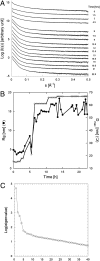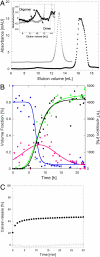Low-resolution structure of a vesicle disrupting α-synuclein oligomer that accumulates during fibrillation
- PMID: 21300904
- PMCID: PMC3044375
- DOI: 10.1073/pnas.1013225108
Low-resolution structure of a vesicle disrupting α-synuclein oligomer that accumulates during fibrillation
Abstract
One of the major hallmarks of Parkinson disease is aggregation of the protein α-synuclein (αSN). Aggregate cytotoxicity has been linked to an oligomeric species formed at early stages in the aggregation process. Here we follow the fibrillation process of αSN in solution over time using small angle X-ray scattering and resolve four major coexisting species in the fibrillation process, namely monomer, dimer, fibril and an oligomer. By ab initio modeling to fit the data, we obtain a low-resolution structure of a symmetrical and slender αSN fibril in solution, consisting of a repeating unit with a maximal distance of 900 Å and a diameter of ∼180 Å. The same approach shows the oligomer to be shaped like a wreath, with a central channel and with dimensions corresponding to the width of the fibril. The structure, accumulation and decay of this oligomer is consistent with an on-pathway role for the oligomer in the fibrillation process. We propose an oligomer-driven αSN fibril formation mechanism, where the fibril is built from the oligomers. The wreath-shaped structure of the oligomer highlights its potential cytotoxicity by simple membrane permeabilization. This is confirmed by the ability of the purified oligomer to disrupt liposomes. Our results provide the first structural description in solution of a potentially cytotoxic oligomer, which accumulates during the fibrillation of αSN.
Conflict of interest statement
The authors declare no conflict of interest.
Figures




Similar articles
-
The N-terminus of α-synuclein is essential for both monomeric and oligomeric interactions with membranes.FEBS Lett. 2014 Jan 31;588(3):497-502. doi: 10.1016/j.febslet.2013.12.015. Epub 2013 Dec 25. FEBS Lett. 2014. PMID: 24374342
-
The role of stable α-synuclein oligomers in the molecular events underlying amyloid formation.J Am Chem Soc. 2014 Mar 12;136(10):3859-68. doi: 10.1021/ja411577t. Epub 2014 Feb 28. J Am Chem Soc. 2014. PMID: 24527756
-
How epigallocatechin gallate binds and assembles oligomeric forms of human alpha-synuclein.J Biol Chem. 2021 Jan-Jun;296:100788. doi: 10.1016/j.jbc.2021.100788. Epub 2021 May 18. J Biol Chem. 2021. PMID: 34019875 Free PMC article.
-
Exploring the accessible conformations of N-terminal acetylated α-synuclein.FEBS Lett. 2013 Apr 17;587(8):1128-38. doi: 10.1016/j.febslet.2013.02.049. Epub 2013 Mar 13. FEBS Lett. 2013. PMID: 23499431 Free PMC article. Review.
-
Structural Characteristics of α-Synuclein Oligomers.Int Rev Cell Mol Biol. 2017;329:79-143. doi: 10.1016/bs.ircmb.2016.08.010. Epub 2016 Oct 31. Int Rev Cell Mol Biol. 2017. PMID: 28109332 Review.
Cited by
-
Native chemical ligation of thioamide-containing peptides: development and application to the synthesis of labeled α-synuclein for misfolding studies.J Am Chem Soc. 2012 Jun 6;134(22):9172-82. doi: 10.1021/ja2113245. Epub 2012 Apr 2. J Am Chem Soc. 2012. PMID: 22468862 Free PMC article.
-
A small-angle X-ray scattering study of alpha-synuclein from human red blood cells.Sci Rep. 2016 Jul 29;6:30473. doi: 10.1038/srep30473. Sci Rep. 2016. PMID: 27469540 Free PMC article.
-
Inhibition of Protein Aggregation and Endoplasmic Reticulum Stress as a Targeted Therapy for α-Synucleinopathy.Pharmaceutics. 2023 Jul 30;15(8):2051. doi: 10.3390/pharmaceutics15082051. Pharmaceutics. 2023. PMID: 37631265 Free PMC article. Review.
-
Beyond Amyloid Fibers: Accumulation, Biological Relevance, and Regulation of Higher-Order Prion Architectures.Viruses. 2022 Jul 27;14(8):1635. doi: 10.3390/v14081635. Viruses. 2022. PMID: 35893700 Free PMC article. Review.
-
Mitophagy in Parkinson's Disease: Pathogenic and Therapeutic Implications.Front Neurol. 2017 Oct 4;8:527. doi: 10.3389/fneur.2017.00527. eCollection 2017. Front Neurol. 2017. PMID: 29046661 Free PMC article. Review.
References
-
- Fink AL. The aggregation and fibrillation of alpha-synuclein. Acc Chem Res. 2006;39:628–634. - PubMed
-
- Volles MJ, Lansbury PT., Jr Vesicle permeabilization by protofibrillar alpha-synuclein is sensitive to Parkinson’s disease-linked mutations and occurs by a pore-like mechanism. Biochemistry. 2002;41:4595–4602. - PubMed
-
- Volles MJ, et al. Vesicle permeabilization by protofibrillar alpha-synuclein: implications for the pathogenesis and treatment of Parkinson’s disease. Biochemistry. 2001;40:7812–7819. - PubMed
-
- Lashuel HA, et al. Alpha-synuclein, especially the Parkinson’s disease-associated mutants, forms pore-like annular and tubular protofibrils. J Mol Biol. 2002;322:1089–1102. - PubMed
Publication types
MeSH terms
Substances
LinkOut - more resources
Full Text Sources

